About the Project
The open-access Royal Inscriptions of Assyria online (RIAo) Project is intended to present up-to-date editions of the officially commissioned texts of the rulers of Assyria from the end of the third millennium BC to the fall of Nineveh in 612 BC.
A bronze sword (MMA 86.11.166.1) from Ashur with an inscription of Adad-nārārī I (1295–1264 BCE).
- A. Kirk Grayson, Assyrian Rulers of the Third and Second Millennia BC (to 1115 BC) (The Royal Inscriptions of Mesopotamia, Assyrian Periods 1; hereafter RIMA 1), Toronto et al.: University of Toronto Press [http://www.utppublishing.com/Assyrian-Rulers-3Rd-and-2Nd-Millenium.html], 1987;
- A. Kirk Grayson, Assyrian Rulers of the Early First Millennium BC I (1114–859 BC) (The Royal Inscriptions of Mesopotamia, Assyrian Periods 2; hereafter RIMA 2), Toronto et al.: University of Toronto Press [http://www.utppublishing.com/Assyrian-Rulers-of-the-Early-First-Millennium-BC-I.html], 1991;
- A. Kirk Grayson, Assyrian Rulers of the Early First Millennium BC II (858–745 BC) (The Royal Inscriptions of Mesopotamia, Assyrian Periods 3; hereafter RIMA 3), Toronto et al.: University of Toronto Press [http://www.utppublishing.com/Assyrian-Rulers-of-the-Early-First-Millennium-BC-II.html], 1996;
- Hayim Tadmor and Shigeo Yamada, The Royal Inscriptions of Tiglath-pileser III (744–727 BC) and Shalmaneser V (726–722 BC), Kings of Assyria (The Royal Inscriptions of the Neo-Assyria Period 1; hereafter RINAP 1), Winona Lake, IN: Eisenbrauns [https://www.eisenbrauns.org/books/titles/978-1-57506-220-4.html], 2011;
- Grant Frame, The Royal Inscriptions of Sargon II, King of Assyria (721–705 BC) (The Royal Inscriptions of the Neo-Assyria Period 2; hereafter RINAP 2), University Park, PA: Eisenbrauns [https://www.eisenbrauns.org/books/titles/978-1-64602-109-3.html], 2021;
- A. Kirk Grayson and Jamie Novotny, The Royal Inscriptions of Sennacherib, King of Assyria (704–681 BC), Part 1 (The Royal Inscriptions of the Neo-Assyria Period 3/1; hereafter RINAP 3/1), Winona Lake, IN: Eisenbrauns [https://www.eisenbrauns.org/books/titles/978-1-57506-241-9.html], 2012;
- A. Kirk Grayson and Jamie Novotny, The Royal Inscriptions of Sennacherib, King of Assyria (704–681 BC), Part 2 (The Royal Inscriptions of the Neo-Assyria Period 3/2; hereafter RINAP 3/2), Winona Lake, IN: Eisenbrauns [https://www.eisenbrauns.org/books/titles/978-1-57506-242-6.html], 2014;
- Erle Leichty, The Royal Inscriptions of Esarhaddon, King of Assyria (680–669 BC) (The Royal Inscriptions of the Neo-Assyria Period 4; hereafter RINAP 4), Winona Lake, IN: Eisenbrauns [https://www.eisenbrauns.org/books/titles/978-1-57506-209-9.html], 2011;
- Jamie Novotny and Joshua Jeffers, The Royal Inscriptions of Ashurbanipal (668–631 BC), Aššur-etel-ilāni (630–627 BC), and Sîn-šarra-iškun (626–612 BC), Kings of Assyria, Part 1 (The Royal Inscriptions of the Neo-Assyria Period 5/1; hereafter RINAP 5/1), University Park, PA: Eisenbrauns [https://www.eisenbrauns.org/books/titles/978-1-57506-209-9.html], 2018;
- Joshua Jeffers and Jamie Novotny, The Royal Inscriptions of Ashurbanipal (668–631 BC), Aššur-etel-ilāni (630–627 BC), and Sîn-šarra-iškun (626–612 BC), Kings of Assyria, Part 2 (The Royal Inscriptions of the Neo-Assyria Period 5/2; hereafter RINAP 5/2), University Park, PA: Eisenbrauns [ https://www.eisenbrauns.org/books/titles/978-1-64602-223-6.html ], 2023; and
- Jamie Novotny, Joshua Jeffers, and Grant Frame, The Royal Inscriptions of Ashurbanipal (668–631 BC), Aššur-etel-ilāni (630–627 BC), and Sîn-šarra-iškun (626–612 BC), Kings of Assyria, Part 3 (The Royal Inscriptions of the Neo-Assyria Period 5/3; hereafter RINAP 5/3), University Park, PA: Eisenbrauns, 2023.
The inscriptions of the Assyrian rulers after 744 BC, from Tiglath-pileser III to Aššur-uballiṭ II, have been made available on RIAo courtesy of Grant Frame, director of the University of Pennsylvania-based and NEH-funded Royal Inscriptions of the Neo-Assyrian Period [http://oracc.museum.upenn.edu/rinap/] (RINAP) Project.
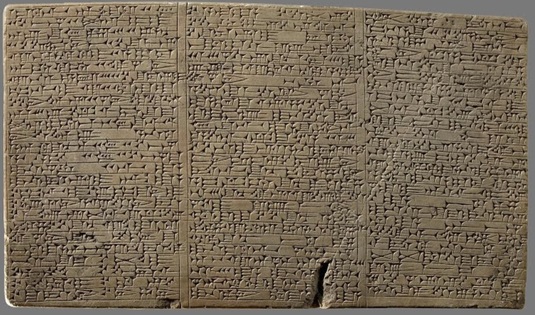
A stone tablet (VA 8832; Ass 19735) from Ashur with a 126-line inscription of
the Middle Assyrian ruler Tukultī-Ninurta I (1233–1197 BC).
Sponsors and timing
The open-access RIAo website was originally created as part of the research project Official Inscriptions of the Middle East in Antiquity (OIMEA), a key sub-project of the Munich Open-access Cuneiform Corpus Initiative [https://www.en.ag.geschichte.uni-muenchen.de/research/mocci/index.html] (MOCCI), which is headed by Karen Radner and Jamie Novotny, and in collaboration with LMU's Institute for Assyriology and Hittitology [https://www.assyriologie.uni-muenchen.de/index.html]. Funding for Phase 1 (August 2015–December 2020) was generously provided by the Alexander von Humboldt Foundation (through the establishment of the Alexander von Humboldt Chair for Ancient History of the Near and Middle East [http://www.ag.geschichte.uni-muenchen.de/lehrstuehle/ls_radner/index.html]) and Ludwig-Maximilians-Universität München (Historisches Seminar - Abteilung Alte Geschichte). Additional financial support for Phase 2 (June 2022–) is not only being provided by LMU Munich (especially through the Cambridge LMU Strategic Partnership [https://www.cambridge.uni-muenchen.de/index.html]; 2019–), but also from the Deutsche Forschungsgemeinschaft (through the award of a Gottfried Wilhelm Leibnitz Prize [https://www2.daad.de/der-daad/daad-aktuell/de/82434-leibniz-preis-fuer-daad-alumna-professorin-karen-radner-im-portraet/] in 2022).
For the material post-745 BC, RIAo proxies in all 1037 (Akkadian and Sumerian) royal inscriptions published in all eight volumes of the RINAP [http://oracc.museum.upenn.edu/rinap/] series. These linguistically-tagged text were made accessible on RIAo through our cooperation partner Grant Frame. For further details, see the RINAP About the Project [http://oracc.museum.upenn.edu/rinap/abouttheproject/index.html/] page.
RIAo began in late 2015 and the first version of this open-access, Oracc-based website was made available in early 2016. The initial objective of RIAo was the retro-digitization and lemmatization (linguistic-tagging) of the 866 Assyrian royal inscriptions (all written in the Akkadian language) published in the three volumes by A. Kirk Grayson for RIM Project (RIMA 1–3), as well as the creation of user-friendly webpages providing some information about Assyria's 116 rulers and the inscriptions written in their names, giving relevant historical, cultural, and archaeological context to these important ancient sources. Phase 1 of RIAo — which was principally carried out by Nathan Morello, with the assistance of Jamie Novotny and Poppy Tushingham, as well as several BA and MA student assistants — was completed in December 2020. All of the texts edited in RIMA 1–3, as well as a few inscriptions not edited in those three volumes, were cataloged and linguistic-tagged, thereby enabling RIAo's users:
- to search catalog metadata by museum numbers, excavation numbers, primary publications, etc.;
- to easily and effectively browse the text editions, with their English translations;
- to export JavaScript Object Notation (JSON) and TEI versions of the RIAo corpus, Akkadian glossary, and index of names; and
- to explore texts by transliteration, individual cuneiform signs, (Akkadian) words, names, as well as by English translations.
Moreover, approximately 175 introductory pages giving historical background and other kinds of information, including translations of (the different versions of) the Assyrian King List (henceforth AKL) and the Synchronistic King List, were prepared during Phase 1.
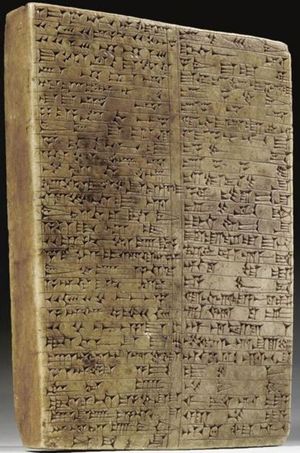
A stone tablet of Tukulti-Ninurta I from Assur now in the Morgan Library and Museum (New York City).
It has been clear from the very start of the project that there has been a growing need to re-evaluate and re-edit the 866 cuneiform inscriptions of Assyria's first 107 rulers that were published by A. Kirk Grayson in 1987–96. Some (minor) corrections were made while lemmatizing the corpus, but, as this was not the aim of Phase 1, the editions and translations that appeared in RIMA 1–3 were not significantly or systematically reworked and updated. Now that the RINAP project (2008–23) has been successfully completed, the time is ripe to re-edit, in an updated form, this important group of Assyrian texts and to add all additional inscriptions that have become known in the three decades since the publication of the RIMA volumes.
Phase 2 formally took shape only in June 2022, when Karen Radner and Grant Frame established the editorial board, team of consultants, and authors of the new Royal Inscriptions of Assyria (RIA) publication series, as well as signed a publication agreement with Eisenbrauns [https://www.eisenbrauns.org], an imprint of Penn State University Press [https://www.psupress.org], in August 2022.
The recently-established RIA publication project (=RIAo Phase 2) aims to provide updated editions of the complete corpus of Akkadian inscriptions of the Assyrian rulers from the late third millennium BC to the reign of Aššur-nārārī V (754–745 BC). In essence, the forthcoming publications of the RIA series will serve as "second editions" of RIMA 1–3. Following the models of RINAP and Royal Inscriptions of the Neo-Babylonian Empire [https://www.en.ag.geschichte.uni-muenchen.de/research/rinbe/index.html] (RINBE), the planned six-volume series will include:
- comprehensive introductions, including information about the historical and geographical contexts of the texts, discussions of the material supports of the inscriptions, and surveys of previous research;
- illustrations in the form of photographs (especially of inscribed objects) and drawings (such as annotated site plans and maps); and
- complete indexes of names of people, places, deities, and temples.
Adopting the editorial principals of the RINAP and RINBE series, the planned volumes of the RIA series, together with its open-access component RIAo, will edit each and every inscription separately and in their entirety. This is especially important for the text corpus of the Middle Assyrian king Adad-nārārī I (1295–1264 BC), whose inscriptions have never been fully edited; the presentation of that group of texts in RIMA 1 (pp. 128–179) conflated the introductions, body, building reports, and concluding formulas of Adad- nārārī I's most important texts, thereby obscuring the number and contents of individual inscriptions.
In order to make the books as accessible as possible, especially for non-specialists and students, the arrangement of texts for each ruler will be reworked, following the model of RINAP, which groups each corpus by provenance and material (e.g., clay, stone, metal); whenever possible, a king's texts will be presented chronologically (from earliest to latest). Not only will the text introductions and commentaries be rewritten in their entirety, the individual text bibliographies will be expanded and updated as required, as will the catalogues of known exemplars whenever new witnesses have been identified and / or whenever additional or new information has come to light about the archaeological context of the inscribed objects.
The transliterations and translations will also be reworked, as needed. In particular, the books' authors will update the translations so that they match the editorial practices of RINAP and RINBE. On the one hand, this will take into account the meanings assigned to certain words that were included in the volumes of the Chicago Assyrian Dictionary (CAD) that appeared only after RIMA 1–3 were published. On the other hand, the update applies especially to the reading of personal and geographic names, which will be harmonized with the now-discipline-standard reference tools The Prosopography of the Neo-Assyrian Empire (PNA; 1998–2011) and Répertoire Géographique des Textes Cunéiformes (especially A.M. Bagg, Die Orts- und Gewässernamen der neuassyrischen Zeit [2007–20]). While the RIM volumes used large translation blocks, RIA and RIAo will break these into smaller units to enable their easier correlation with the Akkadian text, especially for non-specialists and students. The editions will also include more detailed notes than their RIMA counterparts, which only indicated minor (orthographic) variants in very limited on-page notes.
The RIA project, which is part of MOCCI, is the direct successor of the RIM Project (1980–2008) and the RINAP Project (2008–23). Over the next decade (starting in 2022), the RIA team will assemble a complete and authoritative modern presentation of the entire corpus of the royal inscriptions of 107 Assyrian rulers from Assyria's origins to 745 BC, both in six print volumes and in a fully annotated (linguistically tagged), open-access digital format, via the RIAo website. As the texts are updated, the revised and expanded content will be will be disseminated online for free.
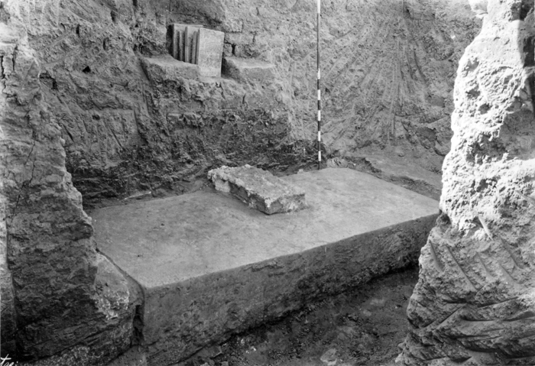
A stone tablet (VA 8832; Ass 19735) from Ashur with a 126-line inscription of
the Middle Assyrian ruler Tukultī-Ninurta I (1233–1197 BC).
Planned Publications
In addition to this open-access, Oracc-based website, the RIA Project will produce six books and open-access PDF versions of those reference volumes, thus making reliable editions of this important group of texts freely available to scholars, students, museum personnel, and the general public. The planned publications are:
- A. Kirk Grayson and Jamie Novotny, The Royal Inscriptions of Assyria, Part 1: From the Origins of Assyria to Arik-dīn-ili (to 1306 BC).
- A. Kirk Grayson and Frauke Weiershäuser (with contributions by Nathan Morello and Jamie Novotny), The Royal Inscriptions of Assyria, Part 2: From Adad-nārārī I to Aššur-rēša-iši I (1305–1115 BC).
- A. Kirk Grayson and Frauke Weiershäuser (with contributions by Joshua Jeffers and Jamie Novotny), The Royal Inscriptions of Assyria, Part 3: From Tiglath-pileser I to Tukultī-Ninurta II (1114–884 BC).
- A. Kirk Grayson and J. Caleb Howard (with the editorial assistance of Jamie Novotny), The Royal Inscriptions of Assyria, Part 4: Ashurnasirpal II (883–859 BC).
- A. Kirk Grayson and J. Caleb Howard (with the editorial assistance of Jamie Novotny), The Royal Inscriptions of Assyria, Part 5: Shalmaneser III and His Successors (858–745 BC).
- Jamie Novotny, Indices, Corrections, and Additions (provisional title).
Project team
RIA Editorial Board
- Karen Radner [http://www.ag.geschichte.uni-muenchen.de/personen/mitarbeiter/radner/index.html] (Alexander von Humboldt-Professorin für die Alte Geschichte des Nahen und Mittleren Ostens, Historisches Seminar – Abteilung Alte Geschichte, Ludwig-Maximilians-Universität München)
- Grant Frame [https://upenn.academia.edu/GrantFrame] (Emeritus Professor of Assyriology, Near Eastern Languages and Civilizations, University of Pennsylvania)
- Jamie Novotny [http://www.ag.geschichte.uni-muenchen.de/personen/mitarbeiter/novotny/index.html] (Akademischer Oberrat, Historisches Seminar – Abteilung Alte Geschichte, Ludwig-Maximilians-Universität München)
- Anmar Abdulillah Fadhil (University of Baghdad)
- Eckart Frahm [https://nelc.yale.edu/people/eckart-frahm] (Professor of Assyriology, Near Eastern Languages and Civilizations, Yale University)
- Barbara Helwing (Vorderasiatisches Museum)
- Jon Taylor (British Museum)
- Ariane Thomas (Louvre Museum)
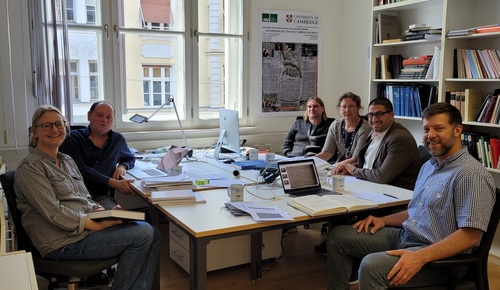
RIA Editorial Board and Authors. From left to right, Radner, Frame, Novotny,
Weiershäuser, Fadhil, and Howard.
RIA Consultants
- Kirk Grayson (Professor Emeritus University of Toronto)
- Helen Gries (Vorderasiatisches Museum)
- Steve Tinney (University of Pennsylvania)
RIA Team (Authors)
- Kirk Grayson
- J. Caleb Howard [https://tyndalehouse.com/about/staff/caleb-howard/] (Research Fellow in Old Testament and Ancient Near East and Editor of Tyndale Bulletin, Cambridge University; Tyndale House)
- Jamie Novotny [http://www.ag.geschichte.uni-muenchen.de/personen/mitarbeiter/novotny/index.html]
- Frauke Weiershäuser (Wissenschaftliche Mitarbeiterin, Historisches Seminar – Abteilung Alte Geschichte, Ludwig-Maximilians-Universität München)
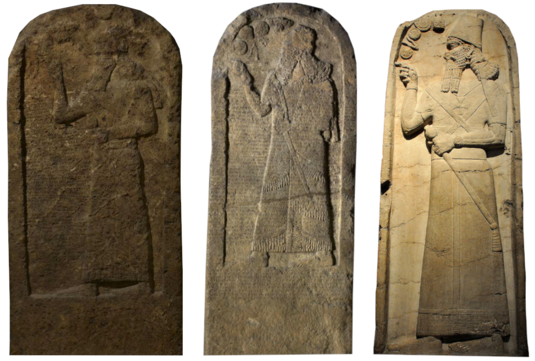
Stone, rounded-topped steles of the early Neo-Assyrian kings Ashurnasirpal II
(BM 118883; left), Shalmaneser III (BM 118884; center), and Šamšī-Adad V
(BM 115020; right).
Official Inscriptions of the Middle East in Antiquity (OIMEA) Editorial Board
- Grant Frame [https://upenn.academia.edu/GrantFrame]
- Jamie Novotny [http://www.ag.geschichte.uni-muenchen.de/personen/mitarbeiter/novotny/index.html]
- Karen Radner [http://www.ag.geschichte.uni-muenchen.de/personen/mitarbeiter/radner/index.html]
OIMEA Advisory Committee
- Rocío Da Riva [http://www.ub.edu/prehist/component/tlpteam/team/dra-rocio-da-riva-munoz] (Professor of Prehistory, ICREA Academia Research Prize Awardee 2014, Departament d'Història i Arqueologia, Universitat de Barcelona)
- Eckart Frahm [https://nelc.yale.edu/people/eckart-frahm]
- Andreas Fuchs [https://uni-tuebingen.de/fakultaeten/philosophische-fakultaet/fachbereiche/altertums-und-kunstwissenschaften/institut-fuer-die-kulturen-des-alten-orients-ianes/institut/mitarbeiter/altorientalische-philologie/fuchs-andreas-apl-prof-dr/] (Außerplanmäßiger Professor and Akademischer Oberrat, Institut für die Kulturen des Alten Orients, Altorientalische Philologie, Eberhard Karls Universität Tübingen)
- Mirjo Salvini [http://independent.academia.edu/MirjoSalvini] (Former Director, Istituto di Studi sulle Civiltà dell'Egeo e del Vicino Oriente, CNR, Roma)
- Mark Weeden [https://www.ucl.ac.uk/classics/people/academic-staff/mark-weeden] (Associate Professor Ancient Middle Eastern Languages, Department of Greek and Latin, University of London)
RIAo Contributors
- Grant Frame [https://upenn.academia.edu/GrantFrame]
- A. Kirk Grayson
- Henry Heitmann-Gordon [http://www.ag.geschichte.uni-muenchen.de/personen/mitarbeiter/heitmann-gordon/index.html] (Wissenschaftlicher Mitarbeiter, Historisches Seminar – Abteilung Alte Geschichte, Ludwig-Maximilians-Universität München)
- Yehonatan Hershkovitz (September 2016–July 2017; then Graduate Assistant, Historisches Seminar – Abteilung Alte Geschichte, Ludwig-Maximilians-Universität München)
- Nathan Morello [https://independent.academia.edu/NathanMorello/Open-access-Projects] (March 2016–December 2020; then Wissenschaftlicher Mitarbeiter, Historisches Seminar – Abteilung Alte Geschichte, Ludwig-Maximilians-Universität München)
- Jamie Novotny [http://www.ag.geschichte.uni-muenchen.de/personen/mitarbeiter/novotny/index.html]
- Poppy Tushingham [https://www.ag.geschichte.uni-muenchen.de/personen/mitarbeiter/tushingham/index.html] (Wissenschaftliche Mitarbeiterin, Historisches Seminar – Abteilung Alte Geschichte, Ludwig-Maximilians-Universität München)
Credits and Copyright
The contents of this website, except where noted below, are the copyright of the OIMEA Project. They are released under a Creative Commons Attribution Share-Alike [http://creativecommons.org/licenses/by-sa/3.0/] license.
This means that you are free to copy, distribute, transmit, and adapt our work without permission, under the following conditions:
- You must attribute the work to the OIMEA project and (if relevant) the author(s), as wll as acknowledge the fact that we are funded by LMU Munich and the Alexander von Humboldt Foundation [https://www.humboldt-foundation.de/web/home.html]. We recommend the following wording: "Based on data prepared by [name of author(s)] for the LMU-Munich- and Humboldt-Foundation-funded OIMEA Project" or "Based on data prepared by the LMU-Munich- and Humboldt-Foundation-funded OIMEA Project".
- If you alter, transform, or build upon any material in this website, you may distribute the resulting work only under the same or similar license to this one.
Any of these conditions may be waived in the right circumstances, if you explicitly ask us for permission.
Read our hints and suggestions for reusing material from Oracc [http://oracc.museum.upenn.edu/doc/help/visitingoracc/reusingoracc/index.html]. For information on how to cite Oracc URLs online and in print, click here [http://oracc.museum.upenn.edu/doc/help/visitingoracc/citingurls/index.html].
Images taken from third-party websites are all credited and linked to those websites, where information about copyright may be found.
Homepage picture credit
Statue of Ashurnasirpal II (BM ME 118871). Credit: Trustees of the British Museum.
Novotny Jamie
Novotny Jamie, 'About the Project', The Royal Inscriptions of Assyria online (RIAo) Project, The RIAo Project, a sub-project of MOCCI, 2023 [http://oracc.museum.upenn.edu/riao/abouttheproject/]